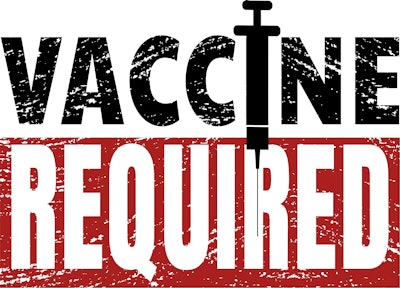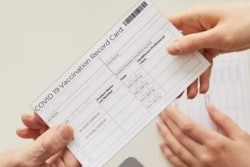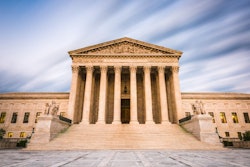
UPDATED NOVEMBER 7, 2021
The Biden administration announced the details of its vaccine requirement on Thursday, and a federal appeals court on Saturday temporarily halted its implementation. If it survives legal challenges, the emergency standard from the Occupational Safety and Health Administration (OSHA) will require businesses with more than 100 employees to begin requiring workers on January 4, 2022, to either get vaccinated or be tested for COVID-19 weekly. The standard would impact roughly 84 million employees in the private sector.
The New York Times reports that a stay issued by a three-judge panel from the U.S. Court of Appeals for the Fifth Circuit in Louisiana, doesn’t have an immediate impact on the standard because the first major deadline in the new rule is December 5, when the guidance would require employers to provide paid time for employees to get vaccinated and masking for unvaccinated workers.
OSHA issued the Emergency Temporary Standard (ETS) after President Joe Biden announced the requirement in September. Under this standard, covered employers must develop, implement and enforce a mandatory COVID-19 vaccination policy, unless they adopt a policy requiring employees to choose to either be vaccinated or undergo regular COVID-19 testing and wear a face covering at work.
Of note, employees who work ‘exclusively outdoors’ are exempt from ETS requirements for vaccination or weekly testing. OSHA provides clarification on the type of work that qualifies for this exemption and there's an easy access to the agency’s clarification in this online high-level ETS summary.
The emergency temporary standard does not require employers to pay for testing, which shifts the weekly cost to employees who opt not to be vaccinated. Employers may be required to pay for testing to comply with other laws, regulations, collective bargaining agreements, or other collectively negotiated agreements. Employers are also not required to pay for face coverings.
A White House Fact Sheet on the ETS is available here.
OSHA’s ETS materials are available here.
The ETS is published in the Federal Register here.
The core of the legal challenge to the standard is the question of whether OSHA exceeded its authority in issuing the rule and whether such a mandate would need to be passed by Congress. The suit charges stated that President Biden “set the legislative policy” of substantially increasing the number of Americans covered by vaccination requirements, and “then set binding rules enforced with the threat of large fines,” which the writers describe as "a quintessential legislative act."
Seema Nanda, chief legal officer for the Department of Labor, issued a statement that the government was confident in its legal authority to issue the vaccination and testing mandate.
“The Occupational Safety and Health Act explicitly gives OSHA the authority to act quickly in an emergency where the agency finds that workers are subjected to a grave danger and a new standard is necessary to protect them,” Ms. Nanda said.
“We are fully prepared to defend this standard in court,” she added.
After both sides have filed briefs, the court will decide whether to lift the temporary injunction, allowing the rule to proceed as planned, or whether to grant a permanent injunction. OSHA could then take the case to the Supreme Court.
In July, President Biden began rolling out vaccination requirements for federal employees and contractors and calling on employers to urge their employees to be vaccinated. Thousands of organizations across the country created a vaccination requirement which The White House says have already helped reduce the number of unvaccinated Americans by approximately 40 percent since July.
Since 2020, the coronavirus has led to the deaths of 750,000 people in the U.S., and the infection of millions more, making it the deadliest pandemic in the nation's history. Many of the people killed and infected by this virus were workers whose primary exposures occurred at their jobs. OSHA estimates that this rule will save thousands of lives and prevent more than 250,000 hospitalizations due to workplace exposure to COVID-19 over the course of the ETS.
“COVID-19 has had a devastating impact on workers, and we continue to see dangerous levels of cases,” said U.S. Labor Secretary Marty Walsh. “We must take action to implement this emergency temporary standard to contain the virus and protect people in the workplace against the grave danger of COVID-19. Many businesses understand the benefits of having their workers vaccinated against COVID-19, and we expect many will be pleased to see this OSHA rule go into effect.”
The emergency temporary standard covers employers with 100 or more employees – firm or company-wide – and provides options for compliance. The ETS also requires employers to provide paid time to workers to get vaccinated and to allow for paid leave to recover from any side effects.
The ETS also requires employers to do the following:
- Determine the vaccination status of each employee, obtain acceptable proof of vaccination status from vaccinated employees and maintain records and a roster of each employee's vaccination status.
- Require employees to provide prompt notice when they test positive for COVID-19 or receive a COVID-19 diagnosis. Employers must then remove the employee from the workplace, regardless of vaccination status; employers must not allow them to return to work until they meet required criteria.
- Ensure each worker who is not fully vaccinated is tested for COVID-19 at least weekly (if the worker is in the workplace at least once a week) or within 7 days before returning to work (if the worker is away from the workplace for a week or longer).
- Ensure that, in most circumstances, each employee who has not been fully vaccinated wears a face covering when indoors or when occupying a vehicle with another person for work purposes.


















